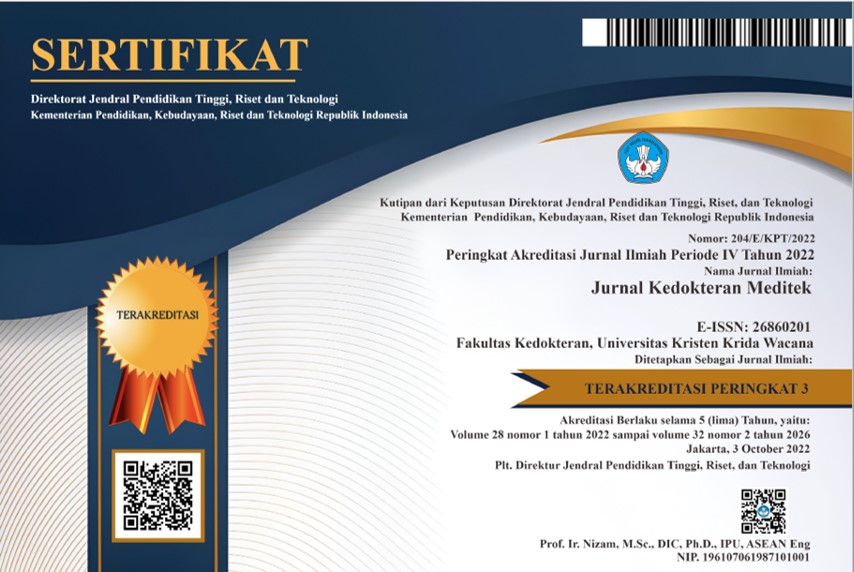Pengaruh Lingkar Paha terhadap Kejadian Cedera Tungkai Atas pada Pemain Futsal
DOI:
https://doi.org/10.36452/jkdoktmeditek.v26i3.1886Keywords:
thigh, injury, futsal playerAbstract
Futsal is a highly intense sport that demands good physical ability, in addition to techniques and tactics in players. Exercise makes individuals healthy but may cause injuries. The risk of injury is higher in sports with frequent physical contact with its opponents while competing, like in football or futsal sports. This literature study aimed to evaluate factors that influence thigh injury in futsal. Thighs are the upper part of the limbs that are always related to the incidence of injury, as they vary in size, such as the circumference, length and muscles. Thighs also consist of fatty tissues. Body fat percentage is associated with muscular endurance. Excess fat can limit the flexibility of muscles, thus affect the quality of the movement. Body Mass Index (BMI) which is ideal to minimize the occurrence of overuse musculoskeletal injury and connective tissue disorder is 21-23kg/m2 for any condition. Studies reported that the uninjured group always tends to be more flexible than the injured group. Previous study also reported that the lack of flexibility or muscle rigidity is found to be the risk factor of injury. In addition, the risk of muscle injury increases significantly (up to four times higher) in players who do not heal properly from muscle strength problems. BMI is also one of the factors related to the increased risk of injury to the lower extremities, especially in thigh injuries. Many studies indicate that thigh circumference influence the upper limbs injury in futsal players.
References
2. Juniarsyah AD, Apriantono T, Adyana IK. Perbandingan karakteristik fisiologi pemain futsal profesional dan amatir dalam dua pertandingan berturut-turut. Jurnal Sains Keolahragaan & Kesehatan. 2016;1(2):46-54.
3. Marom MH, Rohman F. Kondisi psikologis pemain futsal yang pernah mengalami cedera dalam kejuaraan futsal se-kabupaten tuban. Jurnal Kesehatan Olahraga 2014;2(3):103-10.
4. Graha AS, Priyonoadi B. Terapi masase frirage: penatalaksanaan cedera pada anggota gerak tubuh bagian bawah. Fakultas Ilmu Keolahragaan Universtias Negeri Yogyakarta. 2012. h.34
5. Jianxi W, Xianxiao H, Lei Z, dkk. Injuries of futsal players and prevention in china. Int J Sports Exerc Med. 2019;5:145. Diakses dari 10.23937/2469-5718/1510145
6. Schmikli SL, Backx FJG, Kemler HJ, & Mechelen W. National survey on sports injuries in the netherlands: target populations for sports injury prevention programs. Clinical Journal of Sport Medicine. 2009;19(2):101-6.
7. Varkiani, M. E., Alizadeh, M. H., & Pourkazemi, L. The epidemiology of futsal injuries via sport medicine federation injury surveillance system of iran in 2010. Procedia-Social and Behavioral Sciences. 2013;82:946–51.
8. Ribeiro RN, Costa, LOP. Epidemiologic analysis of injuries occurred during the 15th Brazilian Indoor Soccer (Futsal) Sub20 Team Selection Championship. Revista Brasileira de Medicina do Esporte. 2006;12(1):1-5.
9. Mendes JE. Injuries and health problems in football: what everyone should know. 2017. Germany : Springer Nature. h.22-63.
10. Ekstrand J, Hagglund M, Walden M. Epidemiology of muscle injuries in professional football (soccer). American Journal of Sport Medicine. 2011;39(6):1226-32
11. Roberts A. The complete human body the definitive visual guide. America: DK Publishing. 2010. H.23, 245-67.
12. Khan A, Arain A. Anatomy, bony pelvis and lower limb, anterior thigh muscles. 2019. Diunduh tanggal 9 Maret 2020. Diunduh dari https://www.ncbi.nlm.nih.gov/books/NBK538425/
13. Chen BB, Shih TTF, HSU CY,et all. Thigh muscle volume predicted by antropometric measurements and correlated with physical function in the older adults. JNHA: Nutrition. 2011;15(6):1-6.
14. Bahr R. The ioc manual of sports injuries. United Kingdom. 2012;h.1-3
15. Bahr, R. Risk factors for sports injuries a methodological approach. British Journal of Sports Medicine. 2003;37(5):384.
16. Brad W.The anatomy of sports injuries. Second Edition. California: lotus Publishing. 2018. p.37-9.
17. Slowbounov, semyon. Injuries in Athelete Couses and Consequences. The Pennsylvania State University: United States. 2008.
18. Para A. History of futsal. US Futsal. Diakses tanggal 14 Juni 2020. Diakses dari https://futsal.com/history-of-futsal/
19. Saryono. Futsal Sebagai Salah Satu Permainan Alternatif untuk pembelajaran sepakbola dalam pendidikan. Jurnal Pendidikan Jasmani Indonesia. 2006;3(3): 47-58.
20. Abade E, Sampaio J, Gonc¸alves B,dkk. Effects of different re-warm up activities in football players’ performance. PLoS ONE. 2017;12(6):1-13.
21. Silva LM, Neiva HP, Marques MC, dkk. Effects of warm-up, post warm up, and re-warm up strategies on explosive efforts in team sports: a systematic review. Sports Medicine. 2018;48:2285–99.
22. Thies KM, Travers JF. Handbook of human development of health care professionals. Canada: Jones and Bartlett Publisher. 2006. h.167-8.
23. Hruby A, Bulathsinhala L,Mckinnon CJ,dkk. BMI and lower extremity injury in us army soldiers 201-2011. Am J Prev Med. 2016;50(6):163-71.
24. Conti JV. Relationship between flexibility and sport injuries. 2004. Diakses tanggal: 7 Juli 2020. Diakses dari : https://www.efdeportes.com/efd74/injur.html
25. Liemohn, W. Factors related to hamstring strains. Journal of Sports Medicine and Physical Fitness. 1978;(18) :71-6.
26. Croisier JL, Ganteaume S, Ferret JM. Pre-season isokinetic intervention as a preventive strategy for hamstring injury in professional soccer players [abstract]. Br J Sports Med. 2005;39(6):379
27. Nilstad A, Andersen TE, Bahr R, et al. Risk factors for lower extremity injuries in elite female soccer players. The American Journal of Sports Medicine. 2014;42(4):940-8.


















